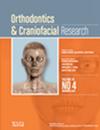Evaluation of different machine learning algorithms for extraction decision in orthodontic treatment
Abstract
Introduction
The extraction decision significantly affects the treatment process and outcome. Therefore, it is crucial to make this decision with a more objective and standardized method. The objectives of this study were (1) to identify the best-performing model among seven machine learning (ML) models, which will standardize the extraction decision and serve as a guide for inexperienced clinicians, and (2) to determine the important variables for the extraction decision.
Methods
This study included 1000 patients who received orthodontic treatment with or without extraction (500 extraction and 500 non-extraction). The success criteria of the study were the decisions made by the four experienced orthodontists. Seven ML models were trained using 36 variables; including demographic information, cephalometric and model measurements. First, the extraction decision was performed, and then the extraction type was identified. Accuracy and area under the curve (AUC) of the receiver operating characteristics (ROC) curve were used to measure the success of ML models.
Results
The Stacking Classifier model, which consists of Gradient Boosted Trees, Support Vector Machine, and Random Forest models, showed the highest performance in extraction decision with 91.2% AUC. The most important features determining extraction decision were maxillary and mandibular arch length discrepancy, Wits Appraisal, and ANS-Me length. Likewise, the Stacking Classifier showed the highest performance with 76.3% accuracy in extraction type decisions. The most important variables for the extraction type decision were mandibular arch length discrepancy, Class I molar relationship, cephalometric overbite, Wits Appraisal, and L1-NB distance.
Conclusion
The Stacking Classifier model exhibited the best performance for the extraction decision. While ML models showed a high performance in extraction decision, they could not able to achieve the same level of performance in extraction type decision.


 求助内容:
求助内容: 应助结果提醒方式:
应助结果提醒方式:


